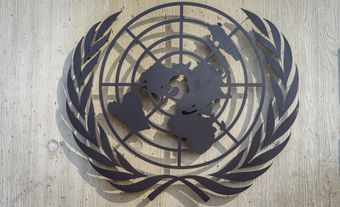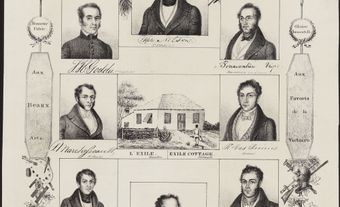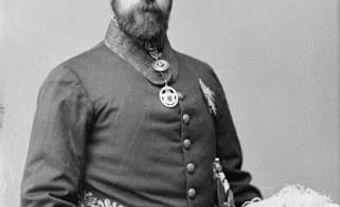This article was originally published in Maclean's Magazine on April 15, 1996
Unabomber Arrested
When the letter-bomb terrorist known as the Unabomber demanded that his 35,000-word diatribe against modern society be published last September, The New York Times and The Washington Post jointly printed the manifesto, insisting that the action could save lives. Six months later, it appears they may have been right. Something twigged for David Kaczynski, a 46-year-old Schenectady, N.Y., social worker, prompting him to look through some of his brother's long-forgotten papers before his mother put the family's Chicago-area home up for sale. The writings by Wanda Kaczynski's older son, a former mathematics professor, were similar enough to pose a heartrending dilemma. By January, mother and brother had consulted a Washington lawyer, who alerted the FBI to the family's suspicions. Agents dressed as lumberjacks and outdoor enthusiasts then began to close in on a Montana loner with an anarchist streak, culminating in a month-long stakeout of a wilderness cabin that ended last week.
Theodore John Kaczynski, 53, was charged with possession of an unregistered firearm after a search of his one-room shack yielded a partial pipe bomb. But investigators frankly declared that the minor charge was a legal device while the search continued for evidence against a man they believe may have detonated 16 bombs in 17 years, killing three people and injuring 23. "We've got all the time in the world now that he's in custody," said one federal agent who did not want to be named. Added another: "We want the irrefutable mother lode of evidence."
If authorities get that proof, it will bring to an end a long, lethal drama that has obsessed U.S. law enforcement officials and worried the academic community since the first bomb went off in the hands of a campus police officer at Northwestern University near Chicago in 1978. The most recent bombing came almost a year ago, on April 24, 1995, when timber industry lobbyist Gilbert Murray was killed by a package mailed to his office in Sacramento, Calif. Coming in the same week and the same state as the FBI's standoff with the so-called Freemen anti-government crusaders in Jordan, Mont., the arrest gave a boost to the agency's tarnished image.
Before charging Kaczynski last week, investigators found 10 three-ring binders filled with bomb-making notes, as well as chemicals, tools and metals that could be used in explosives. "It is my opinion that these components were designed to, could be, and were intended to be readily assembled into a destructive device such as a pipe bomb," wrote FBI special agent Donald Sachtleben in an affidavit filed in a Helena, Mont., federal court. Investigators were also checking two seized manual typewriters that they suspect may have been used to produce the Unabomber's manifesto. And the man in custody is strikingly similar to the psychological profile prepared in 1993 by the multi-agency Unabomb task force: an intelligent yet antisocial white, middle-aged male, well-versed in science and history who had lived in Chicago and California. The task force believes the Unabomber acted alone.
Kaczynski was born and raised in a suburb of Chicago, a brainy student who was a member of the Evergreen Park High School math club. He received a scholarship to Harvard College where he graduated in 1962, going on to receive master's and doctoral degrees from the University of Michigan. He next spent two years as an assistant professor of mathematics at the University of California at Berkeley. Like the Unabomber suspect profile, Kaczynski had few close personal relationships. Last week, only a handful of former classmates and teachers could remember much about him, and even then acute shyness emerged as the enduring image. In 1969, Kaczynski resigned from Berkeley for what John Addison, chair of the math department at the time, vaguely recalled as a desire to pursue social causes. It is unclear how influenced Kaczynski was by the anti-establishment student movement of the time, which was highly active at his Michigan and California campuses. After leaving Berkeley, Kaczynski found his way to Utah, where he worked at a series of odd jobs. He bought land in Montana in 1971 and later built himself a plywood cabin on the Stemple Pass, on the Rocky Mountain continental divide near Lincoln, Mont. (pop. 1,000). Neighbors describe a back-to-the-land eccentric who kept to himself, emerging periodically to buy provisions or take out library books. Kaczynski had no car, made his way around on a old bicycle fitted with snow chains. He had neither electricity nor running water at his secluded perch and grew much of his own food.
"He left people alone and people left him alone," said Bob Orr, manager of the Lincoln Telephone Co. "He was very quiet, a very gentle man," said Beverly Coleman, who used to work at the Lincoln library, where Kaczynski filled his bike saddlebags with borrowed books. "We thought he was all right," added neighbor Dick Lundberg. Locals say Kaczynski dressed in black, sometimes in army fatigues, and usually wore dark glasses.
While the description of an alienated academic fits the FBI's Unabomber profile, Kaczynski's biography contains a major deviation from what many criminologists view as a key factor in the psychology of a serial killer: failure. The math professor was highly accomplished, having achieved a prominent position in his field at an early age. "We know he was a smashing success professionally," said Michael Rustigan, a criminologist at San Francisco State University who has assisted the Unabomb task force. "He has one of the most brilliant careers in the country before him, and then he quits after two years. What happened? That's the question. What happened?"
That may be no easier to answer than why. Hundreds of investigators have fanned out across the country to gather the physical evidence that they need if they are to fit Kaczynski's route and actions into the Unabomber puzzle. Bus and plane tickets and DNA samples from saliva on stamps are among the myriad items that could link a Montana recluse to murders and maimings in California, Michigan, Utah, Washington and Connecticut. The Unabomber, so named for initially targeting universities and airlines, also went after advertising officials, applied science professors and computer experts. After a bomb was left outside a Salt Lake City computer store in 1987, a witness - believed to be the only one to have seen the Unabomber - provided details for the famous sketch of a straggly-haired man wearing sunglasses and a hooded jacket. After the manifesto was published last year, the attacks - as promised - stopped. For how long, nobody could say.
While the Unabomber's publicity blitz may have been designed to spread a political message, last week's result had an intensely personal outcome for the Kaczynski family. As friends and associates came forward with stories of a well-educated family dedicated to liberal causes, Wanda and her son David stayed out of sight, refusing to speak to reporters. An FBI agent said the suspect's brother, who is a youth worker at a shelter for runaway teens and is married to a philosophy professor, was furious that accounts of his role in the investigation became public. David, like his older brother Ted, had attended Harvard and reportedly found it painful to point the finger. Wanda had been proud of both her sons, say acquaintances - not only for their academic achievements, but for their social consciences. In the end, the family's commitment to activism may prove to have led the brothers down drastically divergent paths - one of them terribly twisted.
Maclean's April 15, 1996

 Share on Facebook
Share on Facebook Share on X
Share on X Share by Email
Share by Email Share on Google Classroom
Share on Google Classroom


